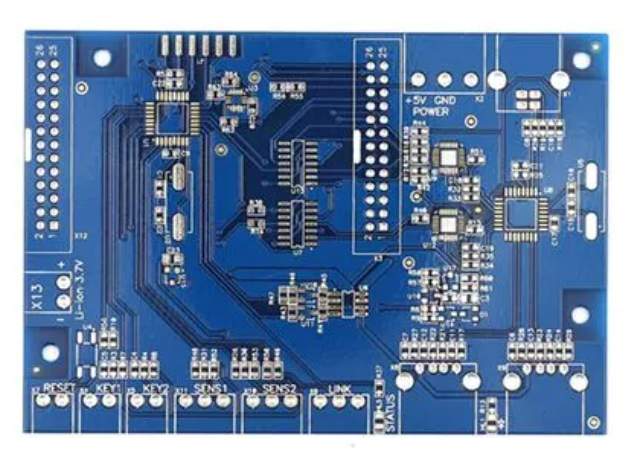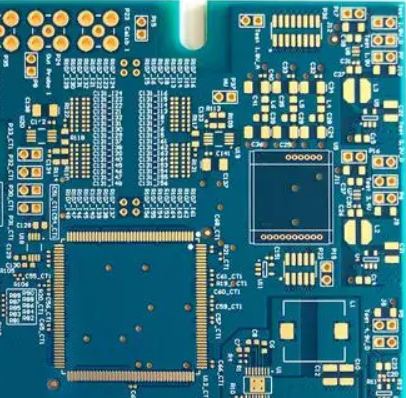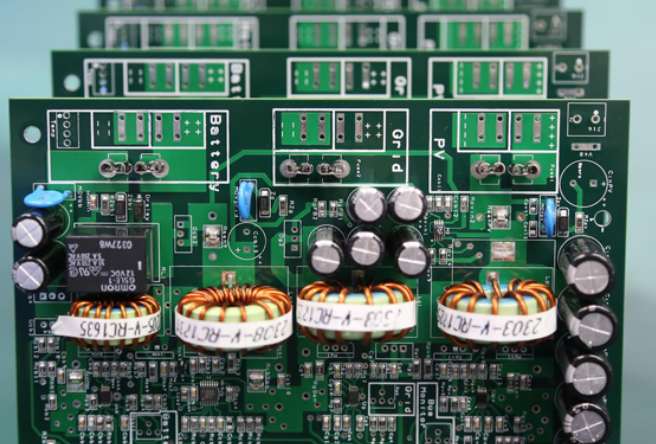
In any design of switching power supply, the physical design of PCB board is the last link. If the design method is not proper, PCB may radiate excessive electromagnetic interference, resulting in unstable power supply. The following steps need to pay attention to the points for analysis.
1. Design process from schematic diagram to PCB
Setup component parameters → input principle netlist → design parameter setting → manual layout → manual wiring → Verification design → review →CAM output.
2. Set parameters
The spacing between adjacent wires must meet the electrical safety requirements, and in order to facilitate operation and production, the spacing should be as wide as possible. When the wiring density is low, the distance between signal lines can be increased appropriately. For signal lines with a wide gap between high and low levels, the distance should be shortened and increased as far as possible. In general, the distance between lines should be set to 8mil. The distance between the inner hole edge of the pad and the printed board edge should be greater than 1mm, so as to avoid the defects of the pad during processing. When the wire connection with the pad is fine, the connection between the pad and the wire should be designed into a droplet shape. The advantage of this is that the pad is not easy to peel, but the wire and the pad are not easy to disconnect.
3. Component layout
It has been proved that the reliability of electronic equipment will be adversely affected even if the circuit diagram is designed correctly and the printed circuit board is not designed properly. For example, if two thin parallel lines on a printed board are close together, there will be a delay in the signal waveform, resulting in reflected noise at the end of the transmission line; Due to the interference caused by the inconsiderate power supply and ground wire, the performance of the product will decline, therefore, in the design of printed circuit board, should pay attention to the correct method. Each switching power supply has four current circuits:
(1) AC circuit of power switch
(2) Output rectified AC circuit
(3) Input signal source current loop
(4) Output load current circuit input circuit
The input capacitor is charged by an approximate DC current, and the filter capacitor mainly plays a role of broadband energy storage. Similarly, output filter capacitors are used to store high-frequency energy from the output rectifier while eliminating DC energy from the output load loop. Therefore, the terminals of the input and output filter capacitors are very important. The input and output current loops should be connected to the power supply only from the terminals of the filter capacitors. If the connection between the input/output loop and the power switch/rectifier loop cannot be directly connected to the terminal of the capacitor, AC energy will be filtered by the input or output capacitor and radiated into the environment.
The AC circuits of the power switch AC circuit and the rectifier AC circuit contain high amplitude trapezoidal current. These currents have a high harmonic component and their frequency is much higher than the switching fundamental frequency. The peak amplitude can be up to 5 times that of the continuous input/output DC current amplitude. These two circuits are the most likely to produce electromagnetic interference, so they must be laid before other printed wires in the power supply. The three main components of each circuit, the filter capacitor, the power switch or rectifier, the inductor or the transformer, should be placed next to each other, and the position of the components should be adjusted to make the current path between them as short as possible.
The best way to establish a switching power supply layout is similar to its electrical design. The best design process is as follows:
1. Place the transformer
2. Design the power switch current loop
3. Design the output rectifier current loop
4. Connect the control circuit to the AC power supply circuit

Design input current source loop and input filter Design output load loop and output filter according to the functional unit of the circuit, the layout of all components of the circuit, to comply with the following principles:
(1) The size of PCB should be considered first. When PCB size is too large, the printed line is long, the impedance increases, the anti-noise ability decreases, and the cost increases. Too small, the heat dissipation is not good, and the adjacent lines are susceptible to interference. The best shape of the circuit board is rectangular, with an aspect ratio of 3:2 or 4:3, and components located on the edge of the board are generally no less than 2mm away from the edge of the board
(2) When placing the device, the future welding should be considered, not too intensive
(3) Take the core component of each functional circuit as the center, and carry out the layout around it. The components should be arranged evenly, neatly and compact on the PCB, and the leads and connections between the components should be reduced and shortened as far as possible. The decoupling capacitor should be as close to the VCC of the device as possible
(4) For circuits working at high frequency, distribution parameters between components should be considered. General circuits should be arranged as parallel as possible. In this way, not only beautiful, but also easy to assemble welding, easy to mass production
(5) Arrange the position of each functional circuit unit according to the circuit flow, so that the layout is convenient for signal flow, and keep the signal in the same direction as far as possible
(6) The first principle of layout is to ensure the distribution rate of wiring, mobile devices pay attention to the connection of the fly line, and put the connected devices together
(7) Reduce the area of loop as much as possible to suppress the radiation interference of switching power supply
4. Wiring
The switching power supply contains high-frequency signals, and any printed line on the PCB can play the role of antenna. The length and width of the printed line will affect its impedance and inductive reactance, thus affecting the frequency response. Even printed lines that pass through the DC signal can couple from neighboring printed lines to the RF signal and cause circuit problems (or even re-radiate interference signals). All printed wires that pass through the AC current should therefore be designed to be as short and wide as possible, which means that all components connected to the printed wires and to other power lines must be placed close together.
The length of the printed line is proportional to its inductance and impedance, and the width is inversely proportional to the inductance and impedance of the printed line. The length reflects the wavelength of the printed line's response. The longer the length, the lower the frequency at which the printed line can send and receive electromagnetic waves, and the more radio-frequency energy it can radiate. According to the size of the printed circuit board current, try to rent the width of the power line, reduce the loop resistance. At the same time, make the direction of the power line, ground line and the direction of the current, which helps to enhance the anti-noise ability. Grounding is the bottom branch of the four current circuits of the switching power supply. As the common reference point of the circuit, it plays an important role. It is an important method to control interference. Therefore, careful consideration should be given to the placement of ground wires in the layout. Mixing all kinds of ground will cause unstable power supply.
5. Check
After the wiring design is completed, it is necessary to carefully check whether the wiring design conforms to the rules set by the designer, and whether the rules meet the requirements of the printed board production process. Generally, it is necessary to check whether the distance between the wire and the wire, the wire and the component pad, the wire and the through hole, the component pad and the through hole, and the through hole meet the production requirements. Is the width of the power cord and ground wire appropriate? Is there any place in the circuit board where the ground wire can be widened? Note: Some errors can be ignored. For example, some connectors have part of their Outline lying outside the frame, and errors occur when checking spacing. In addition, after each modification of the line and hole, it is necessary to re-cover the copper once.
Review according to the "PCB checklist", including the design rules, layer definition, wire width, spacing, pad, through hole Settings, but also focus on the review of the rationality of the device layout, power supply, ground network wiring, high-speed clock network wiring and shielding, the placement and connection of the coupling capacitor.
6. Design output
Note of output light drawing file:
(1) need to output the layer of wiring layer (bottom), screen printing layer (including the top screen printing, bottom screen printing), welding resistance layer (bottom welding resistance), drilling layer (bottom), in addition to the generation of drilling file (NC Drill)
(2) When setting the Layer of the screen printing layer, do not select Part Type, select the Outline, Text and Line of the top layer (bottom layer) and screen printing layer
(3) When setting the Layer of each Layer, select the Board Outline. When setting the layer of the screen printing layer, do not select Part Type, select the Outline, Text and Line of the top layer (bottom layer) and screen printing layer
(4) When generating the drill file, use the default Settings of the Power PCB circuit board and do not change anything







